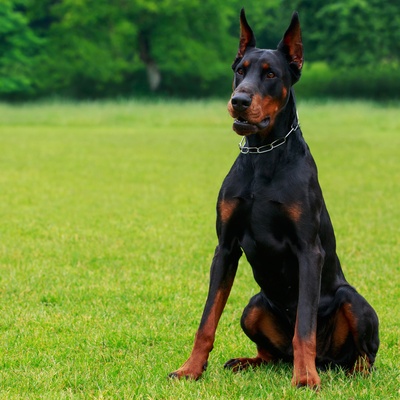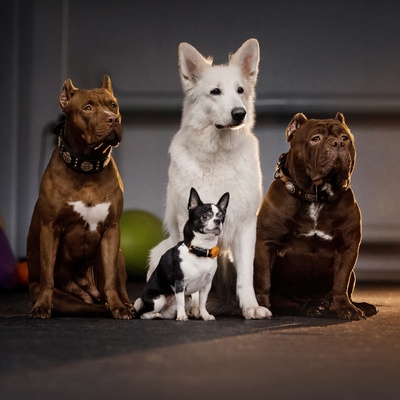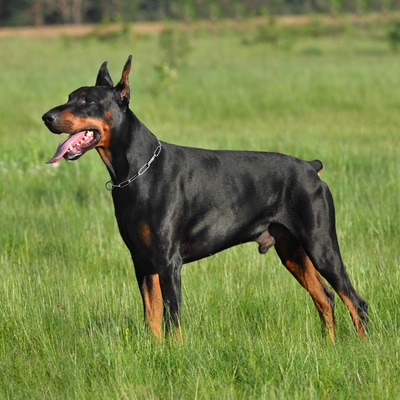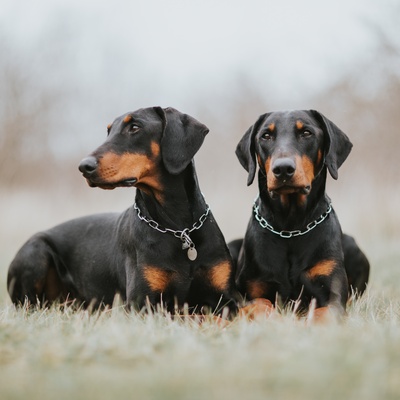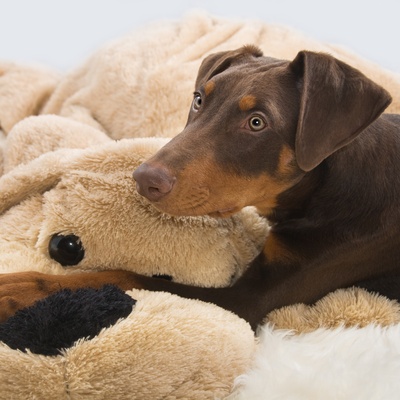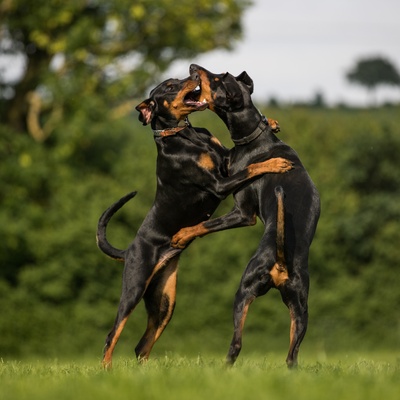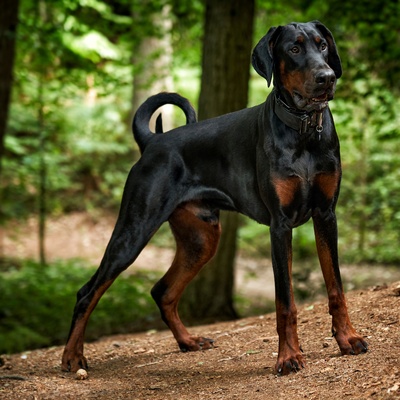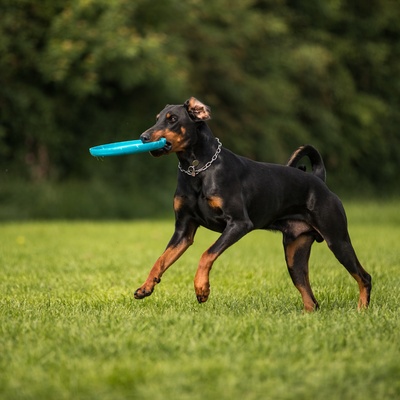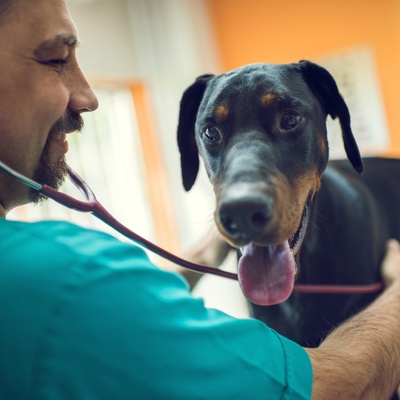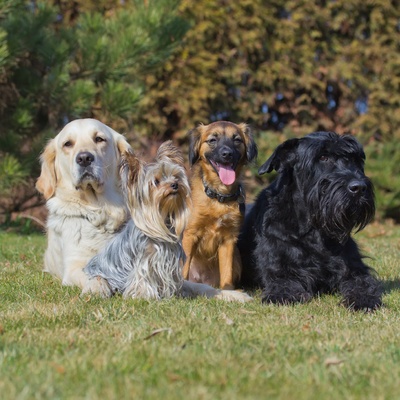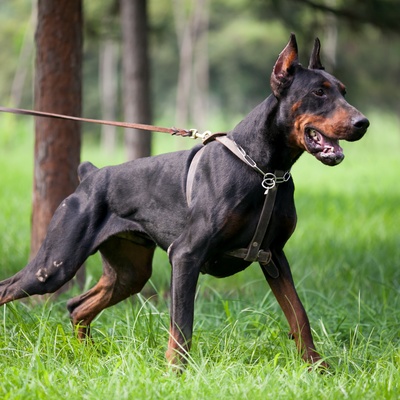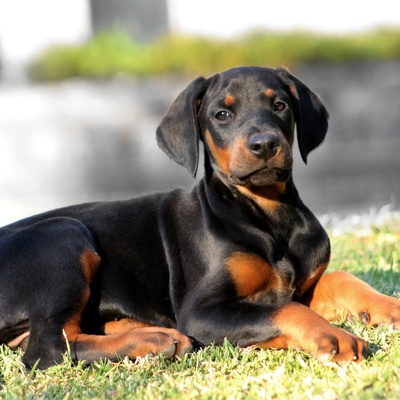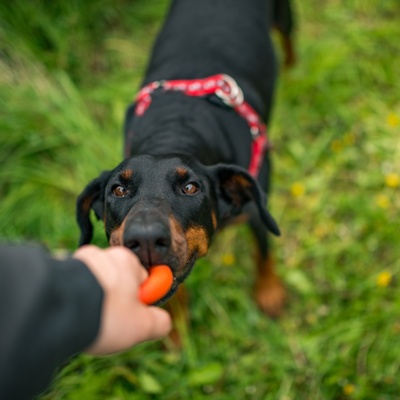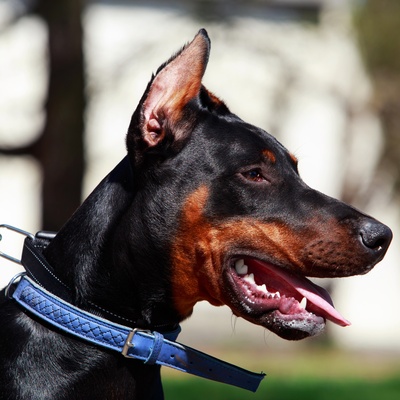Introducing the Doberman
Find out all you need to know about the Doberman: its characteristics, behavior, education and price.
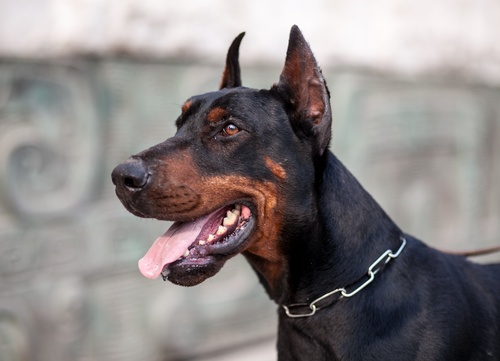
Find out all you need to know about the Doberman: its characteristics, behavior, education and price.
The Doberman, created in Germany at the end of the 19th century, is a symbol of robustness and loyalty. Today, the breed is one of the most respected and admired in the world. Renowned for its courage and exceptional aptitude in a variety of fields, the Doberman excels notably as a watchdog, companion for various sporting activities and even in rescue roles.
Its loyal, protective nature, combined with its affectionate temperament, makes it an excellent companion for families. The Doberman is a socially intelligent dog, showing great affection and loyalty to those close to him.
This section outlines the unique features of the Doberman breed.
The Doberman is from the Group 2 known as the working group, a breed known for its intelligence, strength and versatility.
The Doberman is a large dog with an imposing stature. They generally measure between 22 and 26 inches with a weight varying from 74 to 99 pounds.
Dobermans have a short, smooth, close coat. Their coat is hard to the touch, offering a certain resistance to the elements while being easy to care for.
The Doberman's coat is typically black or brown with well-defined tan markings. Shades can vary from dark brown to reddish.
The Doberman adapts well to different environments, but prefers spaces where it can exercise. A house with a fenced garden is ideal for this active breed.
The Doberman is a friendly, sociable dog, particularly attached to its family. Well socialized, they get along well with children and other pets.
In general, the Doberman enjoys good health, but may be predisposed to certain conditions, including heart problems and hip dysplasia.
The Doberman is an intelligent, receptive dog, which makes it easy to train. The approach must be firm but with an emphasis on patience.
We can help!
Every dog has its own character, and so do you. Making the right choice will ensure his well-being and yours.
Take our quiz to find out which breed is right for you, based on your personality, lifestyle, location and many other criteria.
Don't wait any longer and take the quiz to find out the answer!
The Doberman is a large dog renowned for its powerful, harmonious physique. Its short, glossy coat, typically black or brown with tan markings, accentuates its imposing stature.
Dobermans are one of the larger dog breeds. Females generally measure between 24 and 26,7 inches at the withers, while males reach 25 to 28 inches. In terms of weight, females weigh between 70 and 77 pounds, and males between 88 and 99 pounds.
The Doberman's growth is relatively rapid in its first year, with a phase of intense growth up to six months. Final height and weight are generally reached at around 18 to 24 months, by which time their physical development is complete.
The Doberman has a short, smooth coat, reflecting a neat, elegant appearance. Its hair is close and smooth, without waves or feathering, giving it a glossy, refined appearance that emphasizes the animal's muscularity.
The Doberman has a distinct color palette, with black and brown the dominant hues. These colors are often accentuated by well-defined tan markings above the eyes, on the muzzle, chest and legs, adding a striking contrast to their appearance.
The Doberman's short coat requires relatively simple maintenance. Although it sheds throughout the year, the loss is moderate and can be easily managed with regular brushing. A weekly brushing is generally sufficient to keep the coat clean and shiny. As for bathing, this is only necessary occasionally, unless the dog gets particularly dirty.
Particular attention must be paid to the choice of grooming products to maintain the health of the Doberman's skin and coat.
The Doberman is a majestically balanced and well-proportioned dog, reflecting an athletic and elegant appearance. The head is long and lean, with a flat skull and well-defined muzzle, giving a noble, alert appearance. Their eyes are oval-shaped and often dark brown, expressing vivacity and intelligence.
Their ears, traditionally cropped to remain erect, are set high on the head, but can also be left natural, hanging closer to the skull. The Doberman's body is compact and muscular.
The Doberman is renowned for its loyalty, intelligence and protective instincts. They are affectionate with their family, yet vigilant and confident guardians.
With over 400 dog breeds classified into 10 distinct groups, each group embodies breeds with shared features and traits. The Doberman belongs to the working dog group (group 2). This group, which includes breeds such as the German Shepherd and the Rottweiler, is known for its robustness, intelligence and working ability.
These dogs are distinguished by their ability to learn quickly, their dedication and their versatility in a variety of roles, from protection to assistance. The Doberman, in particular, is prized for its strong guarding instincts, remarkable intelligence and docile, protective character. Their main role is that of guardian, but they also excel in many other tasks, such as search and rescue, and can be a devoted and affectionate family companion.
The Doberman is a dog that stands out for its loyal, alert guarding behavior. Despite its imposing appearance and protective character, the Doberman is extremely affectionate with its family.
It shows its affection easily, and depends heavily on its owner's presence and attention for its development. Although they have a certain independence, they need regular interaction and strong bonds with their humans to be happy.
The Doberman is a sociable, generous dog that gets on well with humans, including strangers, when properly socialized. It can be an excellent companion for children, thanks to its protective nature and calm temperament, provided it is trained and socialized from an early age.
However, due to its large size and strength, supervision of interactions with young children is advised. The Doberman is generally friendly towards other animals, especially if it has been accustomed to their presence from an early age, which underlines the importance of early and varied socialization.
The Doberman is a breed of dog that can adapt to different types of living environments, from apartments to houses with large gardens, in urban or rural settings.
However, this adaptability largely depends on the owner's attention and commitment to his pet. Regular walks, lasting at least 30 minutes twice a day, are essential to maintain its physical and mental well-being.
Although the Doberman can adapt to life in an apartment, it thrives in a more spacious environment, such as a house with a fenced-in garden. Such an outdoor environment allows the Doberman to satisfy its curiosity, expend itself freely and channel its energy.
An outdoor space is particularly beneficial for this breed, as it encourages the physical exercise and mental stimulation essential to its development.
The Doberman is renowned for its remarkable intelligence and ease of learning. These dogs are capable of understanding and executing complex commands, making them particularly suitable for training.
To make the most of their potential, training must be based on consistency, positivity and reinforcement. For owners wanting extra security, the use of a GPS collar, such as those offered by Weenect, can be a practical solution for tracking the dog and preventing possible runaways or losses.
Dobermans are good listeners and receptive to training. They respond well to an educational approach that combines firmness and gentleness. Their protective and loyal nature, combined with a natural aptitude for learning, makes them suitable for a variety of roles, from watchdog to family companion.
To take full advantage of these qualities, it's essential to start training them at an early age and maintain regular training, so as to develop a well-balanced, sociable dog.
Take the test and find out the dog breed that matches your personality and lifestyle.
The Doberman is generally a healthy dog, but like all breeds, it requires careful daily care to prevent disease and infection.
Although robust, the Doberman can be prone to certain genetic health predispositions. Heart problems, such as cardiomyopathy, and joint disorders, such as hip dysplasia, are relatively common in this breed.
They may also be prone to skin disorders or gastrointestinal problems. These health problems require regular vigilance and care. The life expectancy of a Doberman is generally between 10 and 13 years.
Regular veterinary care, including vaccinations, deworming and anti-parasite treatments, is essential for the Doberman. Weekly coat brushing, regular ear cleaning, teeth brushing and nail trimming are also important to maintain health and hygiene.
Allergies can be a problem for some Dobermans, so it's crucial to monitor their reaction to food and the environment, and to consult a vet for personalized advice. The Doberman is not considered a hypoallergenic breed.
The Doberman's diet must be carefully balanced to meet its specific nutritional requirements, essential for vitality and strength. High-quality proteins and vitamins play a crucial role in his diet.
It is strongly recommended to feed the Doberman with premium kibbles specially formulated for large breeds, offering an optimal balance between different nutrients. The addition of lean white and red meat can be beneficial, while taking care to limit fat. It's important to note that each Doberman may have slightly different dietary requirements, and a diet should be adapted accordingly, possibly with veterinary advice.
It's important to take a few factors into account before adopting a Doberman, including cost and associated responsibilities.
Before adopting a Doberman, it's crucial to consider several aspects. Selecting a serious, responsible breeder is essential. A visit to the kennel is recommended to assess the dogs' living conditions and behavior. The health of the puppy and its parents is also an important point; ask the breeder for transparent information on the puppy's current state of health and the parents' medical history.
Lastly, mandatory electronic identification, like microchipping, is not always mandated at the federal level in the United States for dogs. But microchipping is widely acknowledged as a successful way to permanently identify pets and increase the possibility of reuniting lost pets with their owners, even in the absence of universal regulations.
As a pet owner, it is advised to inform yourself about municipal laws to ensure the safety and wellbeing of your pet.
The cost of acquiring a Doberman can vary according to several factors, such as lineage, pedigree, breeder's reputation and the dog's age. On average, the price of a Doberman puppy is between
and
, depending on these criteria.
Doberman maintenance includes food, health care, insurance and equipment, such as a collar, leash and GPS tracker for safety. Annual maintenance costs can vary, but you should generally expect to pay between
and
a year to cover all a Doberman's needs.
Choosing a dog that matches your personality and lifestyle will ensure your well-being and his!
